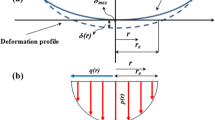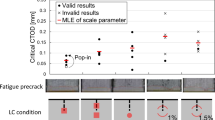Abstract
In the present study, Low Plasticity Burnishing (LPB®) process on the half-space specimen has been simulated using a 3D explicit nonlinear finite element model. The developed finite element model is then used to investigate the effect of main parameters including ball diameter, burnishing force, burnishing feed, and number of passes on the resultant profile of residual stress and plastic deformation. Due to high computational cost associated with the nonlinear finite element model and in order to practically conduct design optimization of the LPB process, the design of experiment combined with the response surface methodology has been used to develop smooth response functions to efficiently and accurately approximate the residual stress profile and plastic deformation over the entire design space. Finally in order to improve the LPB process, a design optimization using the developed response functions has been formulated to obtain the optimum set of parameters such that a deep residual compressive stress with small plastic deformation is generated throughout the thickness of component.
Similar content being viewed by others
References
Zhuang WZ, Halford GR (2001) Investigation of residual stress relaxation under cyclic load. Int J Fatigue 23:31–37
Grinspan AS, Gnanamoorthy R(2009) Development of a novel oil cavitation Jet peening system and cavitation jet erosion in aluminum alloy, AA 6063-T6. Journal of Fluids Engineering. 131, 061301 (8 pages).
Zhang XC, Zhang YK, Lu JZ, Xuan FZ, Wang ZD, Tu ST (2010) Improvement of fatigue life of Ti–6Al–4V alloy by laser shock peening. Mater Sci Eng A 527:3411–3415
U.S. Patent 5826453 (1998), other US and Foreign patents pending.
Seemikeri CY, Brahmankar PK, Mahagaonkar SB(2008) Low plasticity burnishing: an innovative manufacturing method for biomedical applications, Journal of Manufacturing Science and Engineering. 130, 021008 (8 pages).
Prevéy P, Shepard MJ (2000) Surface Enhancement of Ti-6Al-4V Using Low Plasticity Burnishing. 11th AeroMat Conference, Bellevue, WA.
Cammett JT, Prevéy PS (2003)Fatigue Strength Restoration in Corrosion Pitted 4340 Alloy Steel Via Low Plasticity Burnishing. Retrieved from www.lambda-research.com.
Prevéy P (2000) The Effect of Cold Work on the Thermal Stability of Residual Compression in Surface Enhanced IN718. Proc. 20th ASM Materials Solutions Conference and Exposition, St. Louis, Missouri, pp. 426–434.
Prevéy P, Cammett J(2000) Low Cost Corrosion Damage Mitigation and Improved Fatigue Performance of Low Plasticity Burnished 7075-T6. Proc. 4th International Aircraft Corrosion Workshop. Solomons, MD.
Rao DS, Hebbar HS, Komaraiah M, Kempaiah UN (2008) Investigations on the effect of ball burnishing parameters on surface hardness and wear resistance of HSLA dual-phase steels. Mater Manuf Process 23:295–302
Loll NH, Tam SC, Miyazawa S (1991) Investigations on the surface roughness produced by ball burnishing. Int J Mach Tools Manuf 31:75–81
El-Axir MH (2000) An investigation into roller burnishing. Int J Mach Tools Manuf 40:1603–1617
El-Axir MH (2007) An investigation into roller burnishing of aluminum alloy 6061-T6. Proc IME B J Eng Manufact 221:1733–1742
El-Taweel TA, El-Axir MH (2009) Analysis and optimization of the ball burnishing process through the Taguchi technique. Int J Adv Manuf Technol 41:301–310
Klocke F, Bäcker V, Wegner H, Feldhaus B, Baron HU, Hessert R (2009) Influence of process and geometry parameters on the surface layer state after roller burnishing of IN718. Prod Process 3:391–399
Seemikeri CY, Brahmankar PK, Mahagaonkar SB (2008) Investigations on surface integrity of AISI 1045 using LPB tool. Tribol Int 41:724–734
Golden PJ, Shepard MJ (2007) Life prediction of fretting fatigue with advanced surface treatments. Mater Sci Eng A 468–470:15–22
Luca L, Neagu-Ventzel S, Marinescu L (2005) Effects of working parameters on surface finish in ball-burnishing of hardened steels. Precis Eng 29:253–256
JiangY XB, Sehitoglu H (2002) Three-dimensional elastic-plastic stress analysis of rolling contact. J Tribol Trans ASME 124:699–708
Zhuang W, Wicks B (2004) Multipass low-plasticity burnishing induced residual stresses: Three-dimensional elastic-plastic finite element modeling. Proc IMechE C J Mech Eng Sci 218:663–668
BouzidSai W, Sai K (2005) Finite element modeling of burnishing of AISI 1042 steel. Int J Adv Manuf Technol 25:460–465
Yen YC, Sartkulvanich P, AltanT (2005) Finite Element Modeling of Roller Burnishing Process. Annals of the CIRP, 54/1, pp. 237–240.
Maximov JT, Duncheva GV (2011) Finite element analysis and optimization of spherical motion burnishing of low-alloy steel. Proc IMechE C J Mech Eng Sci 226:161–176
Liu Y, Wang L, Wanga D (2011) Finite element modeling of ultrasonic surface rolling process. J Mater Process Technol 211:2106–2113
Sellars C, Tegart WM (1966) On the mechanism of hot deformation. Acta Metall 14:1136–1138
Johnson GR, Cook WH (1985) Fracture characteristics of three metals subjected to various strains, strain rates, temperatures and pressures. Eng Fract Mech 21:31–48
WestmanEL (2003) Development of an inverse modelling programming system for evaluation of Ti-6Al-4V gleeble experiments. Master’s thesis, Lule˚a University of Technology.
Johnson GR (1985) Strength and Fracture Characteristics of a Titanium Alloy (.06Al, .04V) Subjected to Various Strains, Strain Rates, Temperatures and Pressures. Naval Surface Weapons Center NSWC TR, 86-144.
Lesuer D (2000) Experimental investigation of material models for Ti-6Al-4V and 2024– T3, FAA Report DOT/FAA/AR-00/25.
ABAQUS Analysis User’s Manual, ABAQUS. Inc., Version. 6.11. 2011.
Croarkin C, Tobias P (eds) (2006) NIST/SEMATECH e-Handbook of statistical methods.National Institute of Standards and Technology, URL http://www.itl.nist.gov/div898/handbook/.
DuMouchel W, Jones B (1994) A Simple Bayesian Modification of D-Optimal Designs to Reduce Dependence on an Assumed Model. Technometrics 36:37–47
Russell SJ, Norvig P (2003) Artificial intelligence, a modern approach, second ed, McGraw-Hill, New York, pp. 110–116.
Nocedal J, Wright SJ (2006) Numerical Optimization, 2nd edn. Springer, New York, pp 529–576
Fischer-Cripps AC (2007) Introduction to contact mechanics, 2nd edn. Springer, New York, pp 137–150
Author information
Authors and Affiliations
Corresponding author
Additional information
LPB® is a registered trademark of Lambda Technologies Group.
Rights and permissions
About this article
Cite this article
Mohammadi, F., Sedaghati, R. & Bonakdar, A. Finite element analysis and design optimization of low plasticity burnishing process. Int J Adv Manuf Technol 70, 1337–1354 (2014). https://doi.org/10.1007/s00170-013-5406-y
Received:
Accepted:
Published:
Issue Date:
DOI: https://doi.org/10.1007/s00170-013-5406-y




